Letters from Lodi
An insightful and objective look at viticulture and winemaking from the Lodi
Appellation and the growers and vintners behind these crafts. Told from the
perspective of multi-award winning wine journalist, Randy Caparoso.
How LODI RULES for Sustainable Winegrowing is directly addressing climate change
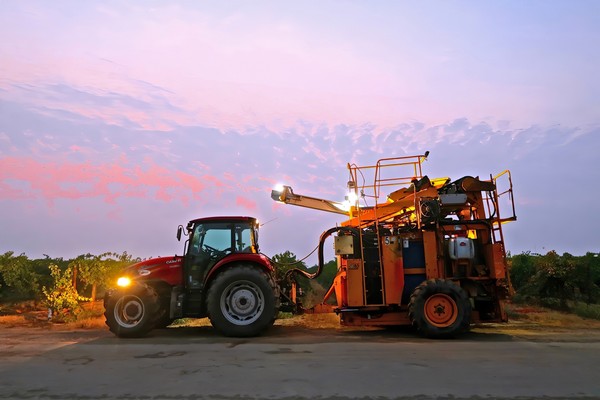
Mechanical harvester in Vino Farms' showcase sustainable vineyard, Grand Vin Lands.
Our recent consecutive days of over 100° F. temperatures are just one of the many signs that our climate is changing as we speak. So is the uptick in forest fires, tornadoes, hurricanes, floods, droughts, and many other weather events posing a direct threat to populations, industries and economies.
So far the distance between Lodi and heavily forested areas have kept the impact of concerns such as smoke taint in grapes and wines grown in the appellation to a minimum, but the threat remains real, the danger imminent.
Glaciers are melting and seas are rising. By how much? Science-based estimates are putting the rise in sea level at nearly 1 foot within the next 30 years, about 2 feet by the end of this century. Bear in mind that that the elevation of Downtown Lodi is just 35 feet. San Francisco is already barely 4 feet above water, and grape growers on the western edge of Lodi are farming in leveed areas below sea level. We won't be around when water below the Lodi Arch reaches people's ankles, but no doubt this will be a serious concern for our descendants.
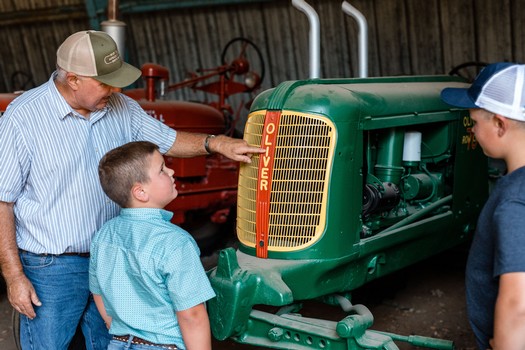
Two generations of Lodi winegrowers. Stephanie Russo.
And that's the thing. Lodi, perhaps more than in any other wine region in California, is a strongly descendant-conscious farming community. It is easily the largest winegrowing region in the U.S., with most of its land currently held by third, fourth, fifth or even sixth generation farming families.
Perhaps more than anything, Lodi's multi-generational culture is the reason why the country's first, formalized, full-fledged system of sustainable farming was founded. The region's crowning achievement, called LODI RULES for Sustainable Winegrowing, was officially launched in 2005, following over 10 years of groundwork and research.
The research goes on as we speak: Particularly in areas addressing greenhouse gas emissions, identified as the primary cause of observable climate change during the past 50 years. One could say that climate change is an inevitability, with or without the influence of what human beings do on or to the planet. Yet no question, the build-up of greenhouse gas in the atmosphere is contributing mightily to the current trend of global warming, manifested in more and more factors that the farmer needs to address on a daily basis.
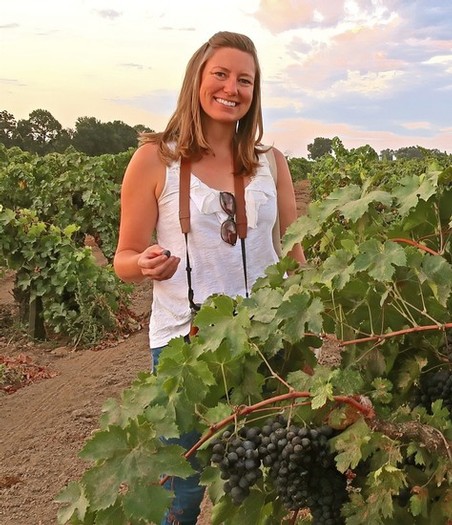
Lodi Winegrape Commission's Dr. Stephanie Bolton among ancient vines in Lodi.
Lodi's Dr. Bolton on prioritizing environmental footprint
I asked Dr. Stephanie Bolton, Lodi Winegrape Commission's director of sustainable winegrowing, research and education, to share some thoughts on how Lodi winegrowers as a group have been addressing climate change. First thing she said:
About 98% of green house gas emissions in viticulture come from fuel and electricity use, with the remaining 2% coming from nitrous oxide.
Nitrous oxide emissions are low in viticulture when compared with irrigated annual crops, likely due to the efficiency of nitrogen application to the roots of vines ("fertigation") during periods of root growth.
At the same time, nitrous oxide has about 300 times more global warming potential than carbon dioxide. It slows the ability of earth to radiate energy back into outer space and depletes stratospheric ozone.It is released in soil when microbes undergo nitrification and denitrification. Nitrification is generally a more significant contributor in viticulture.
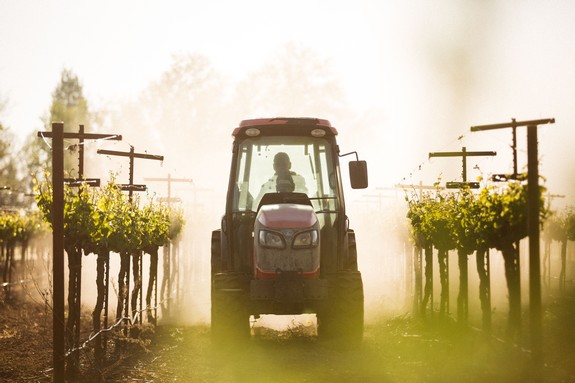
Tractor on Lodi appellation morning. Alina Tyulyu.
For further reading, on the subject of greenhouse gas emissions as they pertain to winegrowing, Dr. Bolton strongly recommends the 2015 paper by Longbottom and Petrie entitled Role of vineyard practices in generating and mitigating greenhouse gas emissions. Introductory snatches from the paper:
Climate change is expected to have a significant impact on the wine industry, and as an industry, it is critical that practices are evaluated to ensure opportunities to mitigate greenhouse gas (GHG) emissions... Fuel and electricity use are significant contributors to the total GHG emissions from viticulture (approximately 98%), with nitrous oxide emissions being low.
Climate change has the potential to significantly change viticulture... Its impact on grapevine physiology and phenology has already been demonstrated by advanced flowering, veraison and ripeness. It is also expected that increasing temperature will affect grape yield and composition... Given that the productive lifespan of a commercial vineyard may exceed 40 years, it is highly relevant to consider the long-term impact of viticultural management practices and assess opportunities for improving the environmental footprint of vineyard operations.

Tom Hoffman, fifth generation Lodi grower, owner/grower of the sustainably farmed Heritage Oak Vineyards. Alina Tyulyu.
Conscious of that "environmental footprint," Dr. Bolton has been steadily introducing numerous new strategies directly addressing climate change to bolster Lodi's sustainable program, with an eye on the impact on the planet simultaneously with the long term health and growth of the winegrowing industry.
Re Bolton's outline contained in a table summarizing the current efforts to mitigate greenhouse gas emissions:
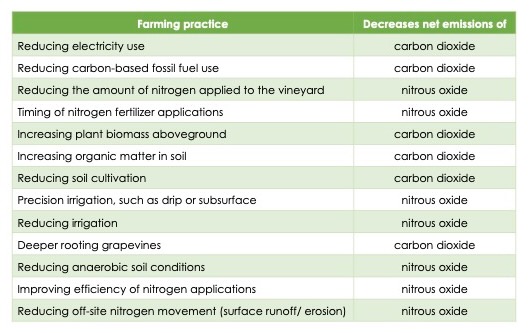
According to Dr. Bolton, "The table can be explained in terms of these simple categories: plants, soil, energy, fertilizer application, and waste." The role of each category, as she explains it:
Plants⏤Having plants in addition to the crop being farmed increases the amount of atmospheric carbon dioxide getting converted into oxygen, energy, and biomass.
Soil⏤Organic matter stored in soil reduces the amount of carbon dioxide released to the atmosphere.
Energy⏤Reduction of the use of carbon-based fossil fuels for energy.
Fertilizer application⏤Minimizing nitrous oxide emissions.
Waste⏤Reducing the amount of waste decreases the need to create new raw materials and goods.
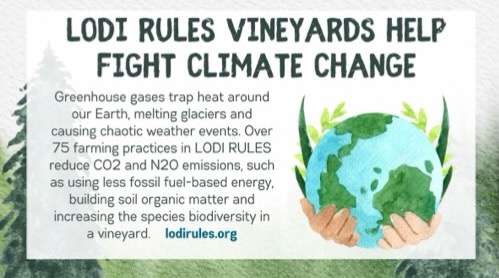
While the work at Lodi Winegrape Commission is being continuously updated, a good chunk of the 125 sustainable "Standards" outlined in the Fourth Edition of LODI RULES for Sustainable Winegrowing (introduced in December 2022) is designed to mitigate greenhouse gas emissions.
For the record, to attain a "Certified Green" seal, a grape grower must be monitored and certified by a third-party organization (Protected Harvest). Although it sets a high bar, as of 2023 there are over 72,000 acres of vineyards certified by LODI RULES in California, 32,812 of those acres within the Lodi AVA itself.
That is to say, the LODI RULES program has garnered so much appeal outside of Lodi that over 39,000 acres are certified in other regions throughout California, representing growers in 13 different California Crush Districts, as well as in Washington and Israel.
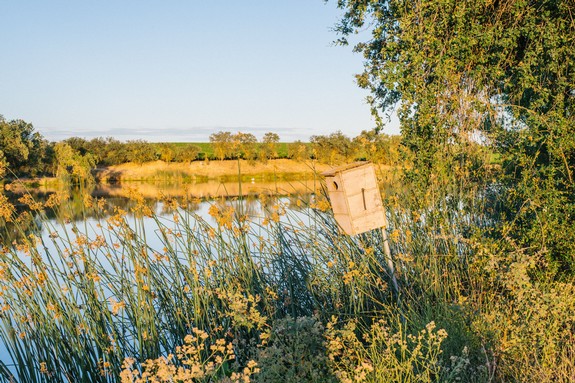
Native plants and bird house in cultivated riparian habitat along Mokelumne River-Lodi vineyrd. Stephanie Russo.
LODI RULES practices that address greenhouse gas emissions
To give you an idea of the rigor and detail involved in LODI RULES farming, Dr. Bolton cites the following areas in which practices are implemented to address greenhouse gas and other sustainable issues, with the ways in which greenhouse gas is mitigated notated in parenthesis:
LODI RULES CHAPTER 1: BUSINESS MANAGEMENT
• Fuel and electricity use are tracked (energy)
• The farming operation uses alternative forms of energy (energy)
• The farming operation increases efficiency of mechanical operations by treating more than one row at a time or by combining two or more mechanical tasks in one pass (energy, waste)
• The importance of recycling is a part of employee orientation and training and the farming operation recycles metal, paper, cardboard, glass and plastic in designated containers (waste)
• The farming operation increases efficiency via automation. (energy, waste)
• Paper-free LODI RULES audit. (waste)
• Training on the carbon cycle (plants, soil)

Fourth generation Lodi winegrower Leonard Manassero harvesting old vine Grenache, planted in the 1940s.
LODI RULES CHAPTER 3: ECOSYSTEM MANAGEMENT
• A cover crop is maintained between at least every other vine row and tilling does not take place during the winter months (plants, soil, energy)
• The farming operation has woodlands (plants, soil)
• The farming operation has enhanced the buffer around woodlands with vegetation (plants, soil)
• There are individual, preserved trees under company control in or adjacent to the vineyard block on company property (plants, soil)
• Vegetation is planted and maintained or at least grows around individual, preserved trees (plants, soil)
• Low stature vegetation (hedgerows, shrubs, etc) is maintained around the vineyard block on company property (plants, soil)
• California native vegetation is maintained on headlands, roadsides, and around trees (plants, soil)
• Seasonal wetlands are preserved with a permanent vegetative buffer strip around the entire perimeter (plants, soil)
• Riparian habitat exists on company property (plants, soil)
• There is a vegetative buffer between vineyards and intermittent water bodies (plants, soil)
• The farming operation has a written and implemented livestock grazing management plan (energy, soil)

The fifth generation of Lodi's Maggio family, owner/operators of Oak Ridge Vineyards—Raquel Maggio-Casity, Lisa Kammerer and Shelly Maggio Woltkamp. Oak Farm Vineyards.
LODI RULES CHAPTER 4: SOIL MANAGEMENT
• The farming operation has a written and implemented nutrient management plan (soil, fertilizer application)
• The farming operation is aware of the erosion and compaction risks of the vineyard soils and has a written and implemented soil conservation plan (soil)
• Soils in the vineyard have been characterized (soil)
• Soils samples from the vineyard have been analyzed and the results incorporated into the nutrient management plan (soil, fertilizer application)
• Throughout the growing season, vegetative cover is maintained between every vine row and not tilled (plants, soil, energy)
• Every other row middle is tilled only as needed with the other row middles left undisturbed (plants, soil, energy)
• Row middles are only tilled as needed (plants, soil, energy)
• Soil pH is between 5.5 and 8.0 (soil, fertilizer application)
• Organic material has been added to the vineyard soils using a cover crop, compost, or manure (soil, fertilizer application)
• Irrigation water is tested and soil amendment programs and nutrient management plans altered according to the results (soil, fertilizer application)
• Soil samples from the vineyard were analyzed for macronutrients and micronutrients and the results are incorporated into the nutrient management plan (soil, fertilizer application)

Lodi wine grape farmer. Stephanie Russo.
• A petiole or leaf blade sample has been sent to a lab for analysis (fertilizer application)
• Nitrogen is applied as a non-mined, biological source (fertilizer application)
• Nitrogen will not be applied this year because adequate amounts are provided by a cover crop and/or irrigation water, and vine tissue analysis indicates that the vines contain adequate amounts of nitrogen (fertilizer application)
• Finished compost is used as a nitrogen source (waste, fertilizer application)
• Non-composted grape pomace, manure, and/or legume-rich green manure cover crop is used as a nitrogen source (fertilizer application)
• For each nitrogen source material, records of the fertility analysis report are kept (fertilizer application)
• Compost, pomace, or manure is incorporated after application and/or green manure cover crops are incorporated immediately after chopping (fertilizer application)
• The spreader is calibrated so that the application rate is known (fertilizer application)
• Compost, pomace, or manure is applied after harvest in the fall and/or in the spring before bud break (fertilizer application)
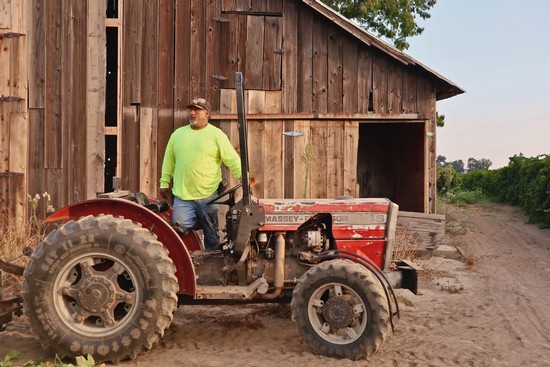
Clements Hills-Lodi AVA harvest tractor driver.
• The amount of applied manufactured or mined nitrogen is limited and never applied when the vine is dormant (fertilizer application)
• The vineyard is never cultivated under dry, windy conditions or a permanent cover is maintained (soil)
• A perennial or native vegetative cover is maintained on the vineyard headlands (plants, soil)
• A hedgerow on the upwind edge of the vineyard serves as a windbreak (plants, soil)
• Slopes are less than 10% or the vineyard follows a reputable erosion control plan (soil)
• Permanent vegetative cover is maintained between every row (plants, soil)
• Any sloped headlands have water erosion control (soil)
• Berms restrict water erosion (soil)
• A vegetative filter strip is maintained on the downslope edge (plants, soil)
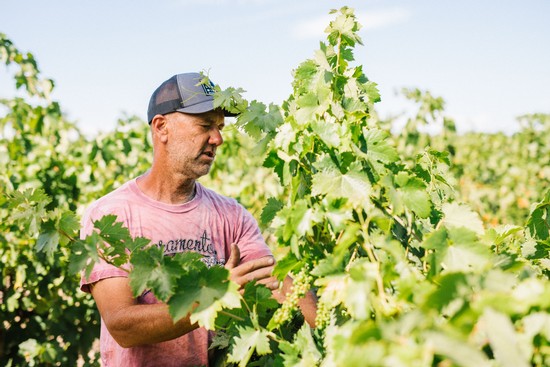
Lodi winegrower Todd Maley, whose family has been farming in Lodi since the late 1860s. Stephanie Russo.
LODI RULES CHAPTER 5: WATER MANAGEMENT
• The farming operation has a written and implemented water management plan (soil, energy)
• Irrigation water is tested for irrigation suitability and the results are incorporated into the water management plan (soil, waste, fertilizer applications)
• The irrigation power plant is electric with renewable energy or the water is delivered by gravity flow without supplemental power (energy)
• The irrigation power plant uses electrical equipment with a time of use plan from a utility district, propane, or diesel (Tier 2 or greater( (energy)
• Irrigation is performed using low volume⏤surface or low volume⏤subsurface systems (fertilizer application)
• In low volume surface irrigation systems, filters gauges, submains, drip lines, and emitters are checked, line leaks are repaired, and clogs are freed (fertilizer application, energy)
• In low volume subsurface irrigation systems, flow meters, pressure gauges, and relief valves are checked and leaks are repaired (fertilizer application, energy)
• Pump efficiency has been measured within the last 5 years or the pump is less than 5 years old (energy)
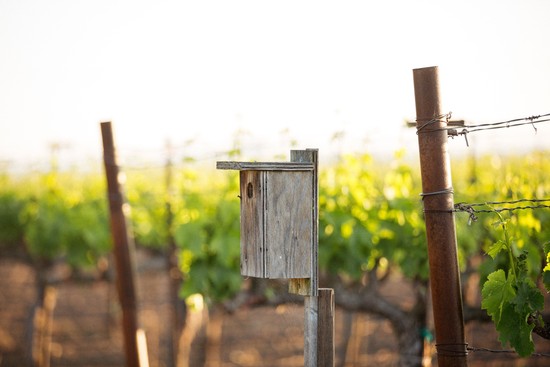
Bird house in Lodi vineyard. Alina Tyulyu.
• Irrigation system distribution uniformity has been tested and recorded or the system uses subsurface drip and relief valves are checked (energy, fertilizer application)
• Soil moisture content is known or soil moisture tension full point (field capacity) is known (soil, energy)
• Soil moisture depletion is determined by soil monitoring devices or the bucket auger/shovel method is used to assist in deciding when and how much to irrigate (soil, energy)
• Vine water status using a device or visual observations is used to assist in deciding when and how much to irrigate (soil, energy)
• Evapotranspiration determined by a local weather station or a nearby CIMIS [California Irrigation Management Information Center] station with similar climatic conditions is used to assist in deciding when and how much to irrigate (soil, energy)
• The amount of water used by the vines on a weekly basis is estimated and recorded and this amount or less is applied to the vines during the next week (unless a heat wave is forecasted or varietal requirements necessitate the use of more water) (soil, energy)
• Irrigation practices create no runoff or runoff is recycled (soil, waste, energy)
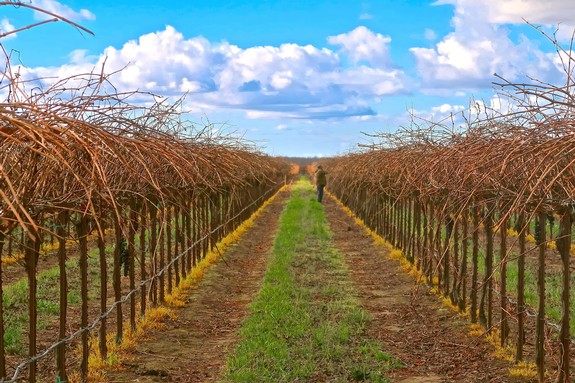
Winter pruning in Lodi's Mokelumne River appellation.
LODI RULES CHAPTER 6: PEST MANAGEMENT
• The farming operation has written and implemented insect/mite and powdery mildew management plans (energy, soil, waste)
• Treatments for leafhoppers and mites are only applied when the economic thresholds are reached (energy, soil, waste)
• When an insect or mite treatment is necessary, only that portion of the vineyard where a problem exists is treated, not the whole vineyard (energy, soil, waste)
• During the growing season, vegetative cover is maintained in at least every other vineyard row (plants, soil, energy)
• During the growing season, vegetative cover is maintained on vineyard roads and avenues (plants, soil, energy)
• A hedgerow and/or vegetative cover is grown on headlands (plants, soil, energy)
• A disease model such as the Gubler-Thomas powdery mildew risk index model is referred to scheduling of powdery mildew fungicide applications (energy, soil, waste)
• For fungicides other than those with negligible risk of resistance development, resistance management is practiced by rotating fungicides and not using chemicals with the same mode of action consecutively (energy, soil, waste)
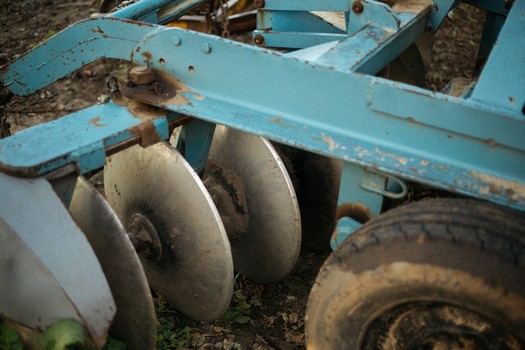
Discing in Lodi. Alina Tyulyu.
• The farming operation has a written and implemented soil borne pest management plan (soil)
• The farming operation has a written and implemented weed management plan which includes scouting (energy, soil, waste)
• Owl boxes, kestrel boxes, and/or raptor perches are provided and maintained (energy)
• The farming operation or the custom applicator has a written and implemented sprayer/duster maintenance plan (energy, soil waste)
• The amount of spray/dust being applied per acre is monitored to ensure that the correct amount is being applied and this procedure includes immediate callibration if any correction is indicated (energy, soil, waste)
• The farming operation has a grapevine virus management plan (waste)
LODI RULES Pesticide Risk Model: PEAS 2.0
• Reduces the amount of pesticide applications (energy, soil, waste)
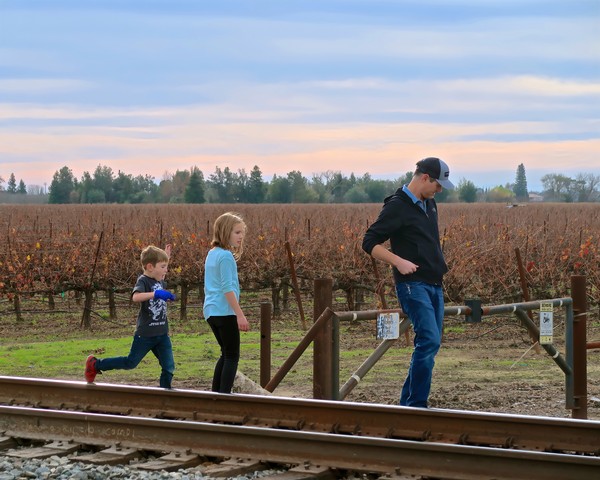
Fifth generation Lodi farmer Aaron Lange with his kids in the the sustainably certified LangeTwins Vineyards.